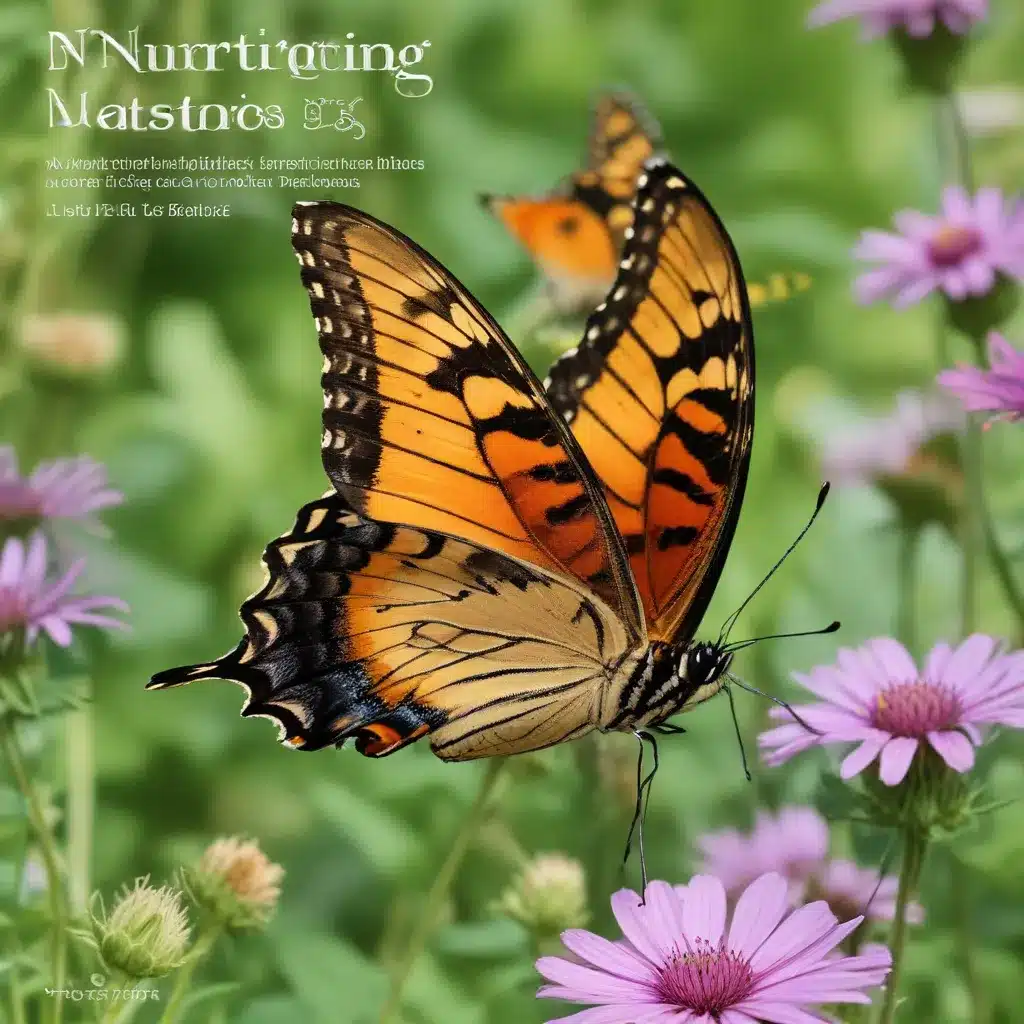
As a farm educator, I’m passionate about helping families discover the wonders of nature, right in their own backyards. At Crooked Pines Farm, we believe that embracing the biodiversity around us is crucial for fostering a healthy, vibrant ecosystem. One of the best ways to do this is by creating a wildlife-friendly garden that attracts our feathered and winged friends – birds and butterflies.
Garden Design for Wildlife
Habitat Creation
When it comes to nurturing nature, the first step is to think of your garden as a potential wildlife habitat. This means providing the essential elements that birds, butterflies, and other creatures need to thrive: shelter and cover, reliable water sources, and a diverse array of native plants.
Shelter and cover can come in many forms, from dense shrubs and evergreen trees to rock piles and log bundles. These safe havens allow wildlife to nest, rest, and hide from predators. Incorporating a variety of these features creates a multi-layered landscape that caters to the needs of different species.
Ensuring access to clean, reliable water sources is also crucial. This can be as simple as a shallow birdbath or as elaborate as a small pond or water feature. Just be sure to keep the water fresh and free of chemicals.
Perhaps the most important aspect of a wildlife-friendly garden is the thoughtful selection of native plants. These local species have evolved alongside the birds, butterflies, and other creatures in your area, providing the specific food and shelter they require. By favoring natives over non-native ornamentals, you’ll create a thriving oasis that supports the entire local ecosystem.
Attracting Avian Visitors
One of the joys of nurturing nature is welcoming our feathered friends to your garden. To attract a diverse array of birds, consider installing feeders and birdbaths that provide reliable sources of food and water. Strategically placing these elements near dense cover will make birds feel safe and secure.
Offering nesting opportunities is another way to invite birds to your garden. Installing birdhouses of various sizes and styles, as well as leaving areas of dead wood or hollow stems, will provide safe havens for cavity-nesting species. Planting native shrubs and trees that produce berries, seeds, and insects will also support birds throughout the year.
Inviting Lepidoptera
Butterflies are not only beautiful, but they also play a crucial role as pollinators in the garden. To attract a variety of lepidoptera, focus on planting nectar-rich flowers that bloom throughout the growing season. Native milkweeds are particularly important, as they serve as host plants for monarch butterfly caterpillars.
Beyond nectar sources, consider incorporating other butterfly-friendly features, such as shallow dishes of wet sand or mud puddles for their puddling behavior. Avoiding the use of pesticides and creating sheltered areas will also help butterflies thrive in your garden.
Seasonal Considerations
Spring Awakening
As the days grow longer and temperatures rise, your garden will come alive with the return of migratory birds and the emergence of early-blooming native plants. Take advantage of this seasonal abundance by planting spring ephemerals, such as wild geraniums or Virginia bluebells, which provide critical early-season nectar and pollen.
Watch for the arrival of migrating songbirds, like warblers and orioles, and provide them with suitable nesting sites and food sources. This is also the prime time for observing the nesting behavior of resident birds, which can be a fascinating educational opportunity for children.
Summer Abundance
As summer settles in, your garden will be teeming with activity. Heat-tolerant native plants will thrive, offering a continuous supply of nectar and pollen for pollinators. Incorporate drought-resistant species and water features to ensure your garden remains a haven during the hottest months.
Observe the vibrant comings and goings of butterflies and hummingbirds as they flit from bloom to bloom. Provide bathing and drinking opportunities, such as shallow dishes or misters, to keep these creatures hydrated and healthy.
Autumn Transitions
As the seasons change, your garden will transition into a fall showcase. Allow native seed heads and dried foliage to remain, as they provide valuable food and shelter for overwintering creatures. The brilliant autumn color of native trees and shrubs will delight the senses.
Keep an eye out for the migration of butterflies, such as the iconic monarch, as they journey to their overwintering grounds. Provide nectar-rich plants to fuel their long flights and create safe resting spots along their route.
Sustainable Gardening
Organic Practices
At Crooked Pines Farm, we believe in embracing organic gardening practices that support the health of our local ecosystem. This means avoiding synthetic pesticides and herbicides, which can have detrimental effects on wildlife and disrupt the delicate balance of the food web.
Instead, we rely on integrated pest management techniques, such as encouraging beneficial insects and using physical barriers to deter pests. Composting and mulching are also essential, as they enrich the soil and reduce the need for chemical fertilizers.
Eco-Friendly Features
In addition to organic practices, we incorporate various eco-friendly features into our gardens to further support wildlife. Rain gardens and pollinator pathways help capture and filter stormwater, while providing vital resources for our winged and crawling friends.
Creating wildlife-friendly structures, such as insect hotels, bat houses, and brush piles, offers valuable shelter and nesting sites for a diverse array of creatures. These features not only enhance the beauty of the garden but also contribute to the overall health and resilience of the local ecosystem.
By embracing these principles of habitat creation, seasonal awareness, and sustainable gardening, we can transform our outdoor spaces into vibrant, nature-rich sanctuaries that enrich the lives of both humans and wildlife. I encourage you to explore the countless ways you can nurture nature in your own backyard, and discover the joy and wonder that comes with observing the intricate dance of life unfolding all around you.
If you’re looking for more resources to get started, be sure to visit Crooked Pines Farm to learn about our educational programs, seasonal events, and family-friendly activities. Happy gardening!


